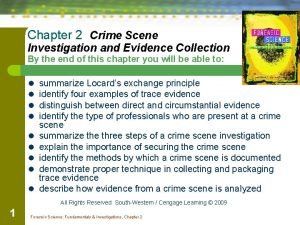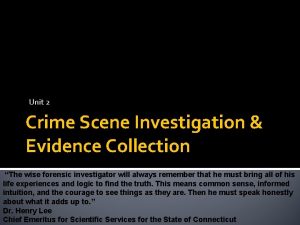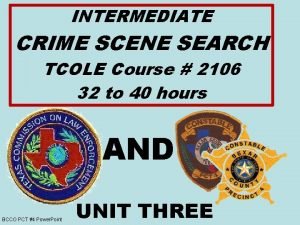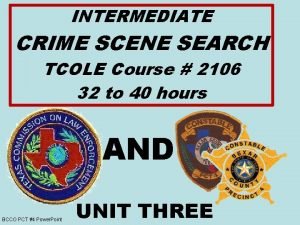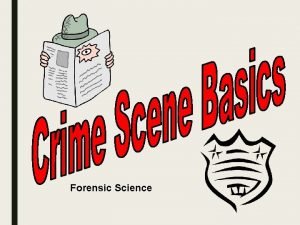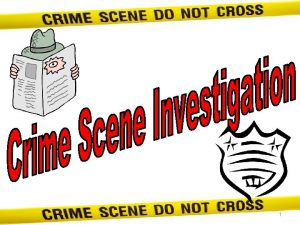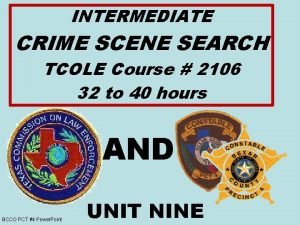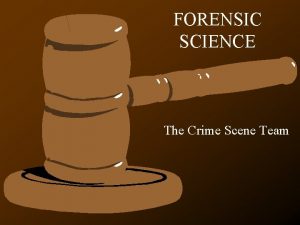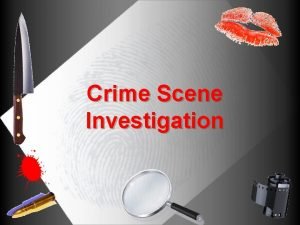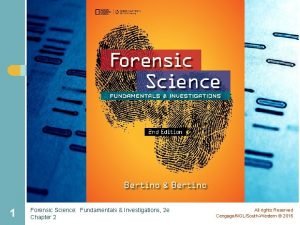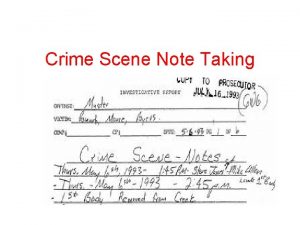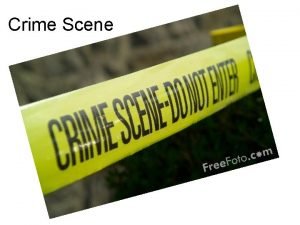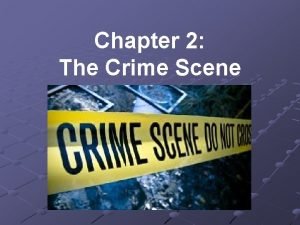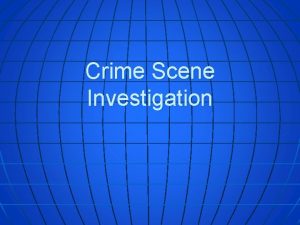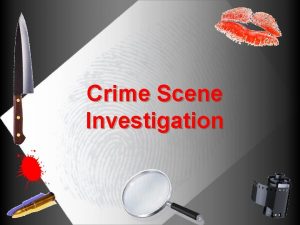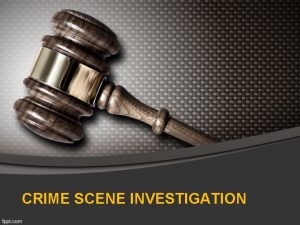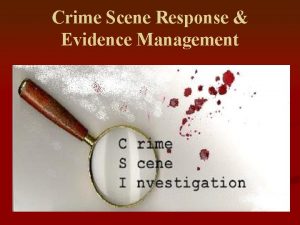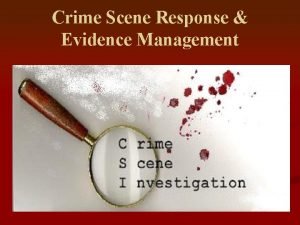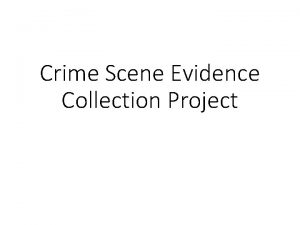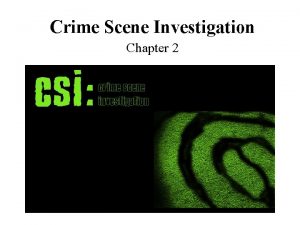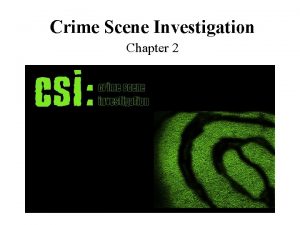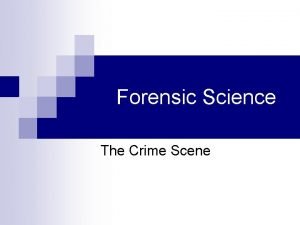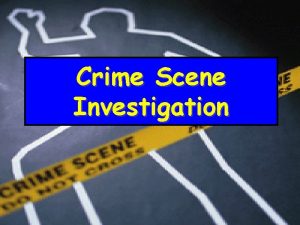Chapter 2 Crime Scene Investigation and Evidence Collection















- Slides: 15

Chapter 2 Crime Scene Investigation and Evidence Collection By the end of this chapter you will be able to: l l l l l summarize Locard’s exchange principle identify four examples of trace evidence distinguish between direct and circumstantial evidence identify the type of professionals who are present at a crime scene summarize three steps of a crime scene investigation explain the importance of securing the crime scene identify the methods by which a crime scene is documented demonstrate proper technique in collecting and packaging trace evidence describe how evidence from a crime scene is analyzed All Rights Reserved South-Western / Cengage Learning © 2009 1 Forensic Science: Fundamentals & Investigations, Chapter 2

Principle of Exchange Dr. Edmond Locard, director of the world’s first forensic lab, established the idea of the exchange principle; namely that: 1. When a person comes in contact with an object or another person, a cross-transfer of physical material can occur. 2. Study of the material can determine the nature and duration of the transfer. 2 Forensic Science: Fundamentals & Investigations, Chapter 2

Types of Evidence l Statements of a witness in court would be direct evidence. l Indirect or circumstantial evidence, such as 3 a fingerprint (physical evidence) or blood or hairs (biological evidence), would imply something, and is called trace evidence. Forensic Science: Fundamentals & Investigations, Chapter 2

Types of Evidence taken from a crime scene. Direct or circumstantial evidence? Physical or biological evidence? Class or individual evidence? Explain why this would be or would not be trace evidence. 4 Forensic Science: Fundamentals & Investigations, Chapter 2

The Crime Scene Investigation Team Who is at the crime scene? l Police and possibly a district attorney. l Crime scene investigators. l Medical examiners. l Detectives. l Specialists. 5 Forensic Science: Fundamentals & Investigations, Chapter 2

The Seven S’s of Crime Scene Investigation Secure the scene. Separate the witnesses. Scan the scene. See to it that the crime scene examiners receive overall and close up photos and video with and without measuring rulers. 5. Sketch the scene. 6. Search for evidence. 7. Secure the collected evidence. 1. 2. 3. 4. 6 Forensic Science: Fundamentals & Investigations, Chapter 2

Packaging the evidence 1. Crease a clean paper and place the evidence 2. 3. 4. 5. 7 in the X position (as shown above). Fold in the left and right sides, and then fold in the top and bottom. Put the bindle into a plastic or paper evidence bag affixing a seal over the opening. Write your name on the seal. Paper or Plastic? Forensic Science: Fundamentals & Investigations, Chapter 2

Chain of Custody 1. 2. 3. 8 In order to present credible evidence in court, a chain of custody log is essential. A person bags the evidence, marks it for identification, seals it, and signs it across the sealed edge (above, left). It is signed over to a technician in a lab for analysis who opens it, but not on the sealed edge. After analysis, the technician puts it back in the evidence bag, seals it in another bag, and signs the evidence log (above, right). Forensic Science: Fundamentals & Investigations, Chapter 2

Analyze the Evidence l The facts of the case are determined when the forensic lab processes all the collected evidence. l The lab then sends the results to the lead detective who aims to see how it all fits into the crime scenario. 9 Forensic Science: Fundamentals & Investigations, Chapter 2

Analyze the Evidence The lab results can: l Show reliable are any witness accounts. l Establish the identity of suspects or victims. l Show suspects to be innocent or link them with a scene or victim. 10 Forensic Science: Fundamentals & Investigations, Chapter 2

Crime Scene Reconstruction Crime scene reconstruction involves: – Time line: – of the sequence of events from before the crime was committed through its commission. – – 11 Forensic Science: Fundamentals & Investigations, Chapter 2

Staged Crime Scenes When the lab results do not match up with the testimony of witnesses, it can mean the crime was staged; common examples include: 12 § Staging a fire—to cover bankruptcy. § Staging a suicide—to cover a murder. § Staging a burglary—to collect insurance money. Forensic Science: Fundamentals & Investigations, Chapter 2

Staged Crime Scenes To help determine whether a crime scene was staged, consider: l Whether the type of wound found on the 13 victim matches the weapon employed. l Whether the wound could have been easily self-inflicted. l The mood and actions of the victim before the event. l The mood and actions of a suspect before the event. Forensic Science: Fundamentals & Investigations, Chapter 2

. . Summary. . . . l Locard’s exchange principle: contact between 14 people and objects can transfer material that can determine the nature and duration of the transfer. l Evidence can be direct or indirect (physical or biological traces). l A crime scene investigation team consists of police, detectives, crime scene investigators, medical investigators, and specialists. l The investigation consists of recognizing, documenting, and collecting evidence. Forensic Science: Fundamentals & Investigations, Chapter 2

. . . . Summary l First responding officers identify the extent of the crime scene, secure it, and segregate witnesses. l Crime scene investigators document the crime scene. l Evidence must be collected, packaged, and labeled. l The evidence then is analyzed and interpreted to fit the crime scenario. 15 Forensic Science: Fundamentals & Investigations, Chapter 2
 Locard exchange principle
Locard exchange principle Seven s's of crime scene investigation description
Seven s's of crime scene investigation description Crime scene investigation 2106 tcole course
Crime scene investigation 2106 tcole course Intermediate crime scene search #2106
Intermediate crime scene search #2106 Oconnors bakery
Oconnors bakery Crime scene vocabulary
Crime scene vocabulary Tcole 2106
Tcole 2106 Corpus delicti
Corpus delicti Crime scene investigation background
Crime scene investigation background Line/strip search pattern
Line/strip search pattern The seven s's of crime scene investigation definition
The seven s's of crime scene investigation definition Intermediate crime scene investigation texas
Intermediate crime scene investigation texas Crime scene note taking
Crime scene note taking Linear search pattern crime scene
Linear search pattern crime scene Evidence crime scene
Evidence crime scene Druggist fold steps
Druggist fold steps
